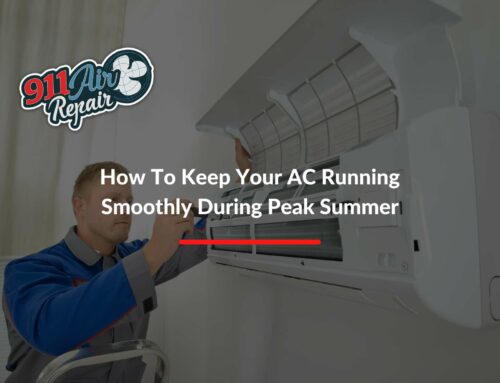Keep Your Home Safe & Secure: Understanding Carbon Monoxide & Its Dangers
Your HVAC system keeps your home comfortable year-round, but without proper care, it can also introduce hidden dangers. One of the most critical issues homeowners should be aware of is the potential for carbon monoxide (CO) leaks, a colorless and odorless gas that can be deadly.
Here’s what you need to know about detecting CO leaks from your HVAC system to keep your home safe and secure.
What Is Carbon Monoxide?
Carbon monoxide is an invisible gas that results from the incomplete combustion of fuels such as natural gas, propane, and oil. It’s commonly produced by appliances and systems like furnaces, water heaters, and even stoves. Being both odorless and colorless, CO is difficult to detect without specialized tools or noticing specific symptoms.
In high concentrations, CO can deprive the body of oxygen, which can lead to serious health problems or even death. That’s why it’s vital to know if your HVAC system could be a source of a potential CO leak.
Common Causes Of Carbon Monoxide Leaks In HVAC Systems
In many homes, heating, ventilation, and air conditioning (HVAC) systems can inadvertently create CO if they are not functioning properly. A leak could be caused by a malfunctioning furnace or a blocked vent, which prevents CO from being safely exhausted out of the home. HVAC contractors recommend annual maintenance to ensure these issues are detected and repaired before they become hazardous.
Some common causes of CO leaks include:
- Cracked Heat Exchanger: The heat exchanger in a furnace can develop cracks over time, allowing CO to escape into your home.
- Blocked Vents or Chimneys: Obstructions can trap carbon monoxide, preventing it from exiting safely.
- Improperly Installed Equipment: If your HVAC installation wasn’t completed to code, CO might escape into the home.
Signs Your HVAC System Might Be Leaking Carbon Monoxide
Detecting a CO leak can be challenging without the proper equipment. However, there are several warning signs that could indicate a potential leak. It’s crucial to pay attention to these symptoms and act quickly if you notice any of them.
- Physical Symptoms: Unexplained symptoms like headaches, dizziness, nausea, or fatigue in family members could be early signs of CO exposure. If symptoms improve when outside the home, this may indicate that CO is present indoors.
- Soot or Streaks Around Appliances: Black or brown streaks around your furnace or vents could be a sign of incomplete combustion, a primary source of carbon monoxide. If you notice these, schedule an inspection right away.
- Condensation On Windows & Walls: Excess moisture around your HVAC system or on windows and walls can be a sign that your furnace is not operating efficiently and may be leaking CO.
- Yellow Pilot Light: A healthy pilot light should burn blue. If it’s yellow or orange, this could indicate improper combustion, which may lead to CO leaks. Contact a Maricopa HVAC contractor or AC professional immediately if you notice this issue.
How To Protect Your Home With Carbon Monoxide Detectors
The most effective way to protect against CO leaks is to install carbon monoxide detectors in your home, especially near bedrooms and your HVAC system. Detectors alert you to elevated CO levels, providing an essential warning of potential danger. Check your detectors regularly, replace batteries as needed, and make sure that they are functioning properly.
Test your detectors monthly and replace them every five to seven years to ensure they function effectively, as sensors may degrade over time. These simple steps could save lives by providing an early warning before CO levels reach dangerous levels.
The Role Of Regular Maintenance In Preventing Carbon Monoxide Leaks
Preventative maintenance is the best strategy to protect your family from CO leaks. A Maricopa HVAC company can provide annual inspections and tune-ups to ensure your system operates efficiently and safely. Routine maintenance should include cleaning vents, checking for blockages, and inspecting the heat exchanger for any signs of wear or damage.
Hiring a certified professional ensures peak performance and early detection of potential issues. Many HVAC companies offer maintenance contracts, making it easier to schedule consistent service without needing to remember each year.
What To Do If You Suspect a CO Leak In Your HVAC System
If you believe there might be a CO leak in your home, take immediate action to keep everyone safe:
- Evacuate Immediately: If you suspect elevated CO levels, leave the building without delay. Symptoms can worsen quickly, so don’t wait.
- Call Emergency Services: Contact your local fire department or emergency services to report the potential leak. They can help confirm the presence of CO and assist with ventilation if necessary.
- Seek Medical Attention: If anyone shows signs of CO poisoning, get medical help immediately. Be sure to tell the healthcare provider about the possibility of carbon monoxide exposure.
- Contact an HVAC Professional: Once your home is deemed safe, reach out to an HVAC expert to inspect your system and address any underlying issues that may have caused the leak.
Why Choose 911 Air Repair For Your HVAC Needs?
When it comes to protecting your home from carbon monoxide and other HVAC-related risks, trust our expert Maricopa HVAC contractors at 911 Air Repair. With a reputation for quality service, fair pricing, and extensive experience, 911 Air Repair offers comprehensive HVAC solutions that keep your home safe and comfortable. Whether it’s a new installation, routine AC repair, or a thorough inspection, our licensed and insured team is here to help.
Let 911 Air Repair give you peace of mind and a safer, more efficient HVAC system. Contact us today to schedule a free in-home estimate or to learn more about how we can help with your heating and cooling needs.
19756 N John Wayne Pkwy STE 106,
Maricopa, AZ 85139
Phone: (480)-360-1234
Email: support@911-ac.com








